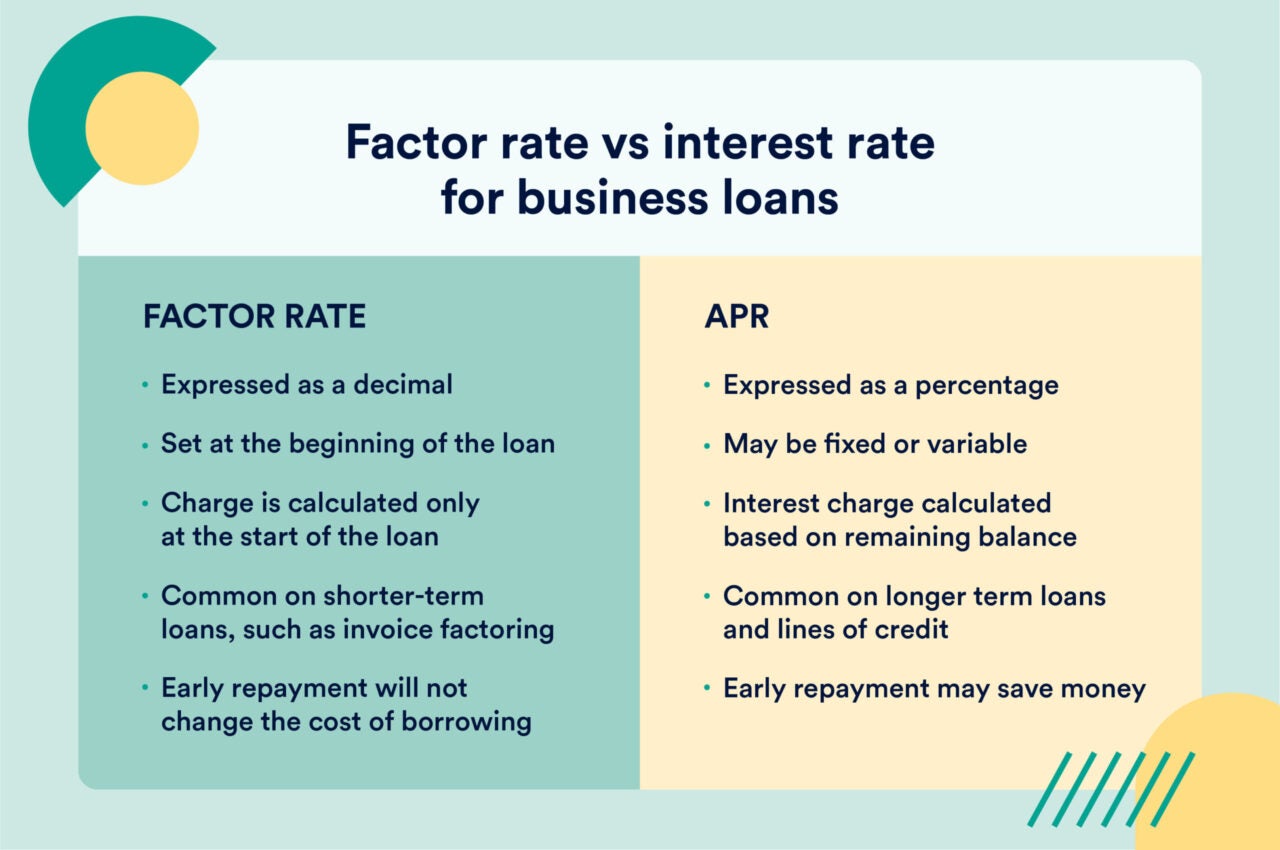Factor rate vs. interest rate for business loans

The Bankrate promise
At Bankrate we strive to help you make smarter financial decisions. While we adhere to strict , this post may contain references to products from our partners. Here's an explanation for .
Key takeaways
- Factor rates represent the percentage of the loan amount required for repayment
- Online and alternative lenders frequently use factor rates
- Interest is paid upfront with loans using factor rates, so early repayment won’t save businesses money
Getting a small business loan comes at a cost. You might be familiar with interest rates, given how common they are for consumer loans, but some business loans charge interest in a different way, called a factor rate.
Understanding the difference between factor rates and interest rates and how they influence the cost of borrowing for your company will help you choose the right loan for your situation.
What is a factor rate?
A factor rate is a percentage of the loan amount that you need to pay to repay the loan. Factor rates are expressed as decimals.
For example, if you get a $50,000 loan with a factor rate of 1.10, you need to pay 110 percent of the amount you borrowed — $55,000 — to pay the loan off. Depending on your company’s creditworthiness and the type of loan you’re getting, factor rates tend to range from about 1.10 to 1.50 or higher.
Keep in mind that factor rates don’t account for any other costs, such as fees, that may apply to the loan. You’ll need to account for those separately if applicable.
Factor rates are most common on short-term loans and other types of alternative funding, such as merchant cash advances.
When are factor rates used?
Lenders often use factor rates to provide a simple and predictable way to assess the cost of borrowing. Factor rates are frequently utilized by online or alternative lenders, especially those specializing in rapid funding. These rates are common in various financial products, including:
- Short-term loans: Borrowers receive a lump sum of money that must be repaid within a relatively brief period, typically no longer than two years.
- Merchant cash advances: Businesses receive upfront cash in exchange for a percentage of their future credit card sales.
A few lenders that offer some of the best short-term business loans use factor rates, including:
What is an interest rate?
An interest rate is a percentage of the loan’s principal that the lender charges as a fee for borrowing money. Typically, the interest rate is expressed as a percentage of the principal per year.
For a simplified example, if you had a $10,000 loan with a 10 percent interest rate and made no payments, the loan’s balance would be $11,000 after one year.
Annual percentage rate (APR) is another way of expressing the interest rate of a loan. It accounts for the loan’s basic interest rate along with its compounding schedule. It also includes any fees charged, making it a more accurate expression of borrowing costs.
For a business loan, interest rates start as low as 5 percent. But they can exceed 30 percent if you’re getting an online loan with poor credit.
Interest rates, including APRs, are common with traditional lenders offering longer-term loans and lines of credit. Additionally, you may also see simple interest, which is interest that’s calculated only on the principal amount throughout the life of the loan.
Finding the total cost of a loan based on its APR takes some calculations. Use our small business loan calculator to find the total cost of borrowing with a loan that uses interest rates.
Factor rate vs. APR interest rate
Lenders use both factor rates and APR to express the cost of a loan. However, each method works slightly differently.

Which is better?
Both factor rates and APR have pros and cons. There’s no one answer to which is better.
Factor rates, for example, make it far easier to calculate the cost of borrowing money. Just multiply the principal by the rate, and you’re done. With APR, the calculation takes longer, especially for multi-year loans.
But with a loan that uses interest rates, you can save money if you pay the loan off early. Imagine you have a five-year loan with a balance of $20,000 and an interest rate of 7 percent. Your monthly payment is about $396, and the loan’s total cost will be $23,761.
If you add $104 to your monthly payment so you pay an even $500 per month, you’ll pay off the loan 14 months early. You’ll also reduce the loan’s total cost to $22,841, saving $920 overall.
Simply put, opting for a loan with interest rates allows potential savings through early repayment — as long as there aren’t any prepayment penalties — unlike loans with factor rates where the cost is fixed upfront. However, if you have a lower personal credit score and seek quick, predictable financing, a short-term business loan with a factor rate may be preferable.
How to convert a factor rate into an interest rate
If you’re comparing loans that use factor rates to loans that use interest rates, the best thing to do is convert the factor rate into an interest rate. This will let you compare the loans more easily.
To convert a factor rate to an interest rate, follow these steps.
- Subtract 1 from the factor rate.
- Multiply the resulting decimal by 365 (the number of days in a year)
- Divide the result by the number of days in your loan term
- Multiply by 100 to find the interest rate
For example, if you have a $25,000 loan with a factor rate of 1.25 and an expected repayment term of 180 days, the calculation would look like this:
- 1.25 – 1 = .25
- .25 x 365 = 91.25
- 91.25 / 180 = .5069
- .5069 x 100 = 50.69%
Note that this calculation will find the interest rate of a loan, not the APR. It doesn’t include fees.
Why term length matters
Loan term plays a big role in the interest rate of a loan that uses factor rates. The same factor rate converts to a higher interest rate over a short term and a lower interest rate over a longer term.
This is because interest rates express the cost of the loan as a percentage of the loan amount per year. With factor rates, the loan’s term does not influence how much you pay because the cost is a flat amount based on the initial principal of the loan. Spreading the loan out over more payments won’t change its overall cost, leading to a lower effective rate.
Keep this in mind when you’re comparing loans with factor rates to loans that use interest rates.
To compare a loan that uses a factor rate to one with an interest rate, you can convert the factor rate into an interest rate — or simply compare each option’s final total cost.
Bottom line
Factor rates and interest rates are both ways to express the cost of getting a business loan. Each has pros and cons, so it’s important to understand how they work and how to compare them to each other.
Once you know how they work, you can use that information to find the best small business loan to help your company grow.
Frequently asked questions
-
To convert a factor rate to interest, you must:
- Subtract 1 from the factor rate
- Multiply by 365
- Divide by the number of days in your loan term
- Multiply by 100
-
Both factor rates and interest rates have their benefits. Factor rates offer simplicity and predictability as its a fixed cost. However, they can result in higher borrowing costs compared to traditional loans using interest rates, which offer businesses a chance at savings with prepayment — as long as there aren’t any prepayment penalties.
-
Factor rates determine the total repayment amount by multiplying the borrowed sum by the factor rate, providing an upfront fixed cost.
Related Articles



